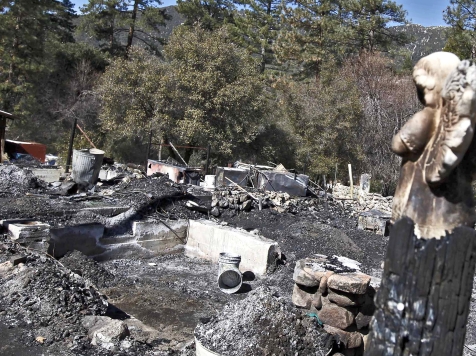The Los Angeles Times, ever eager to implicate the LAPD in anything it can get its hands on, is now questioning whether the use of a strong tear gas that can cause a fire was the right tactic for the LAPD when they cornered alleged murderer and cop-killer Christian Dorner.
Never mind that night was about to fall and Dorner, hiding in a cabin near Big Bear Lake, had not given any evidence that he would surrender, even after numerous loudspeaker calls for him to give up. Never mind that there was a possibility that the former LAPD cop might have night goggles, and could have murdered more police officers if he escaped. Never mind that he was still in the cabin despite previous tear gas attempts to drive him out. Never mind that a demolition vehicle tore down most of the walls, thus leaving the interior exposed. Never mind that Dorner was still firing at officers, as one officer said, “Any time they moved, this guy was shooting.”
Just minutes after the more powerful tear gas was used, the cabin was on fire.
The Times was happy to print that Samuel Walker, emeritus professor of criminal justice at the University of Nebraska Omaha, criticized the LAPD: “It’s true, he was firing at them. But he was cornered. He was trapped. At that point, there was no rush in the sense that he was barricaded. The standard rules on barricade situations are that you can wait the person out.To use a known incendiary device raises some very serious questions in my mind.”
In the interest of appearing balanced, The Times quoted former LAPD officer David Klinger, who is a use-of-force expert at the University of Missouri at St. Louis:
What difference does it make if one of the officers puts a … round in his head, drives the armored vehicle over his body when they are knocking the building down, or he dies in a conflagration? If he is trying to surrender you can’t do any of those things … But if he is actively trying to murder people, there’s no doubt that deadly force is appropriate and it doesn’t matter what method is used to deliver it.
And Geoffery Alpert, an expert on police tactics at the University of South Carolina, agreed, “I don’t understand what the big deal is. This man had already shot two officers and was suspected of murdering other people. He wasn’t responding in a rational manner. The actions you take have to remove the threat and if it requires extreme measures, then so be it.”
But leave it to the Times to even bother making an issue of it.

COMMENTS
Please let us know if you're having issues with commenting.